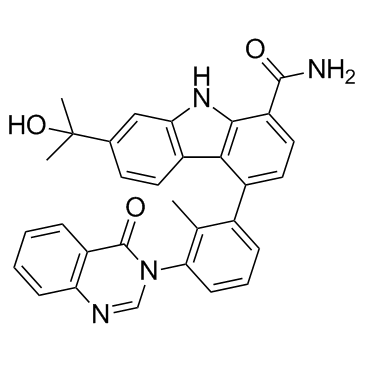| Description |
BMS-935177 is a potent and selective reversible inhibitor of Bruton’s tyrosine kinase (Btk) with an IC50 of 3 nM.
|
| Related Catalog |
|
| Target |
IC50: 3 nM (BTK)[1]
|
| In Vitro |
In B cells stimulated through the BCR, BMS-935177 selectively inhibits several different readouts. BMS-935177 inhibits calcium flux in human Ramos B cells (IC50=27 nM) and inhibits CD69 surface expression in peripheral B cells stimulated with antiIgM and anti-IgG. However, BMS-935177 has no effect on CD69 surface expression in B cells stimulated through the CD40 receptor with CD40 ligand. Against IgG-containing immune complexdriven low affinity activating Fcγ receptor (FcγRIIa and FcγRIII) end points in peripheral blood mononuclear cells (PBMCs), BMS-935177 effectively inhibits TNFα production with an IC50 value of 14 nM. BMS-935177 shows mean IC50 values of 550±100 (n=11) and 2060±240 nM (n=3) in human and mouse whole blood, respectively[1].
|
| In Vivo |
When dosed orally once daily at 5, 20, and 45 mg/kg to mice, BMS-935177 inhibits anti-KLH antibodies of the IgG isotype at day 14, with statistically significant reductions at all doses. In satellite mice from this study dosed with 6 at 5 mg/kg, the plasma concentration is maintained above the mouse whole blood BCR-stimulated CD69 IC50 value of 2 μM for only approximately 5 h. At once daily oral doses of 10, 20, and 30 mg/kg beginning on the day of primary immunization, BMS-935177 provides a clear dose-dependent reduction in both the severity and incidence of clinically evident disease in this rodent model of RA. At 10 mg/kg of BMS-935177, disease severity is reduced about 40% compared to vehicle treatment, and the percentage of animals showing any signs of disease is reduced by a third[1].
|
| Kinase Assay |
BMS-935177 is dissolved at 10 mM in DMSO and evaluated at 11 concentrations . To V-bottom 384- well plates are added BMS-935177, human recombinant BTK (1 nM), fluoresceinated peptide (1.5 μM), ATP (20 μM (Km app)), and assay buffer (20 mM HEPES, pH 7.4, 10 mM MgCl2, 0.015% Brij 35 surfactant, and 4 mM DTT in 1.6% DMSO), with a final volume of 30 μL. After incubation at room temperature for 60 min, the reaction is terminated by adding 45 μL of 35 mM EDTA to each sample. The reaction mixture is analyzed on the by electrophoretic separation of the fluorescent substrate and phosphorylated product (excitation, 488 nm; emission, 530 nm)[1].
|
| Animal Admin |
Rats[1] Male Sprague−Dawley rats (255-298 g) are used in the PK studies. To investigate the oral bioavailability of BMS-935177 after crystalline microsuspension doses, rats receive BMS-935177 by oral gavage (1, 5, and 20 mg/kg), T99.5% 10 mM citrate buffer, pH 4, 0.02% DOSS, Methocel A4M. Serial blood samples are obtained after oral dosing at 0.25, 0.5, 0.75, 1, 2, 4, 6, 8, and 24 h postdose. Plasma samples, obtained by centrifugation at 4 °C (1500-2000g), are stored at −20 °C until analysis[1]. Mice[1] Efficacy of BMS-935177 (10 and 30 mg/kg) vs vehicle and dexamethasone (Dex) is studied in a mouse anti-collagen antibody-induced arthritis (CAIA) inflammation model. Mice are injected intraperitoneally (ip) with a mixture of four monoclonal antimouse type II collagen antibodies (1 mg of each). Daily oral dosing is immediately started with vehicle (EtOH:TPGS:PEG300, 5:5:90), BMS-935177 (10 or 30 mg/kg), or dexamethasone (dex, 1 mg/kg). Three days later, the mice are injected ip with 1.25 mg/kg LPS. Thereafter, mice are monitored 3×/ week for the development and severity of paw inflammation[1].
|
| References |
[1]. De Lucca GV, et al. Small Molecule Reversible Inhibitors of Bruton's Tyrosine Kinase (BTK): Structure-Activity Relationships Leading to the Identification of 7-(2-Hydroxypropan-2-yl)-4-[2-methyl-3-(4-oxo-3,4-dihydroquinazolin-3-yl)phenyl]-9H-carbazole-1-carboxamide (BMS-935177). J Med Chem. 2016 Sep 8;59(17):7915-35.
|
